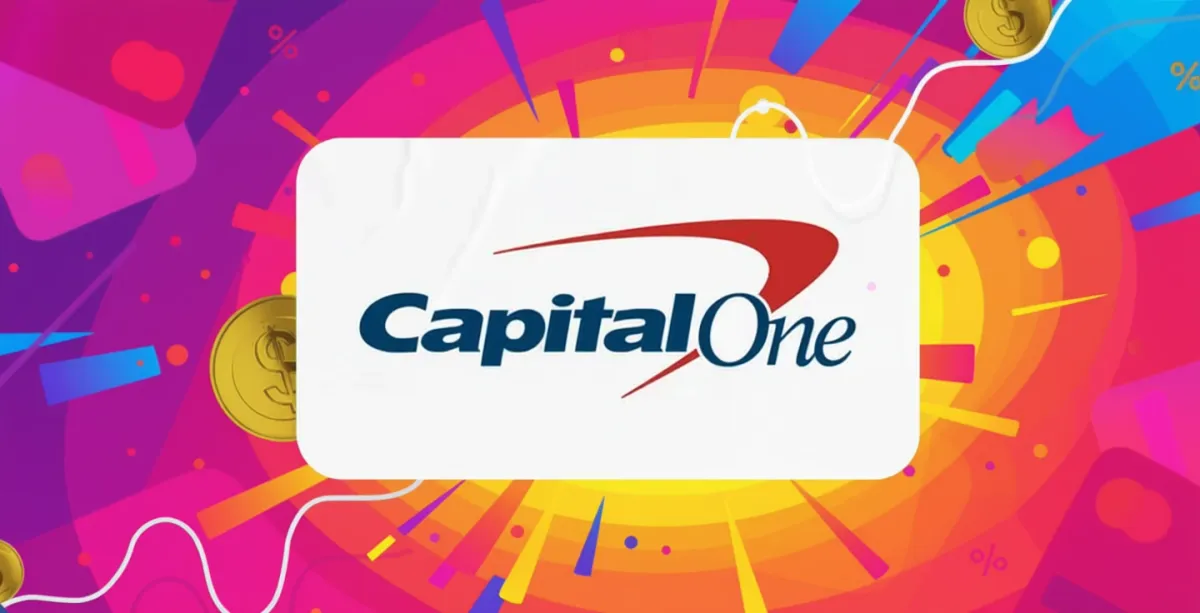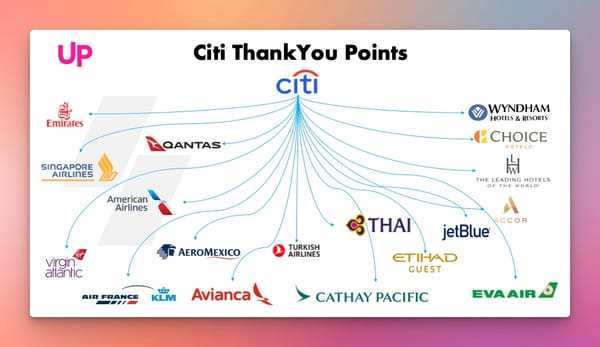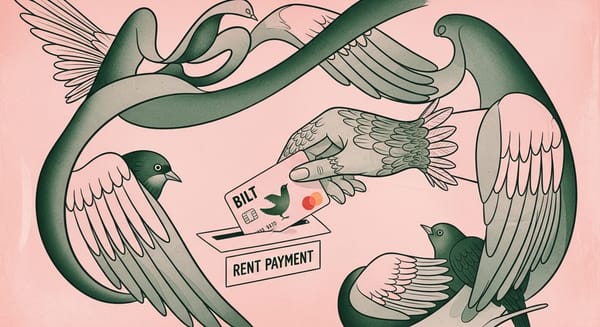CapitalOne Miles: The End of Easy Value (Q4-2025 Field Manual)
CapitalOne built its empire on simplicity: flat earn rates, frictionless redemptions, and marketing that made points feel like cash with wings. That model doesn’t work anymore... Today their miles are fighting for definition in a world where partners are tightening, and arbitrage is vanishing.


If You Only Had 60 Seconds to Read This Article
| Click Here 🤏🏻
CapitalOne has entered its post-simplicity era. What was once the easiest travel currency - 2× on everything, 1:1 transfers everywhere - now sits in a tightening market where yield depends entirely on timing and discipline. The rumored end of 1:1 Emirates transfers signals a structural shift: the golden age of guaranteed parity between banks and airlines is closing. Every redemption is now a trade, and the spread between “good” and “lazy” execution widens by the month.
The portal is no longer a refuge. Powered by Hopper’s live fare engine, its prices swing like an FX chart. On good days it beats cash; on bad days it quietly taxes your points. The erase-function economy that once defined Venture cards has eroded under inflation and dynamic pricing, forcing users to treat miles as working capital, not coupons. CapitalOne’s clean interface hides a volatile reality - its simplicity now demands strategy.
For high-yield travelers, the ecosystem’s strength lies in its elasticity: you can pivot between portal, partners, and cash faster than with Amex or Chase. But that elasticity cuts both ways; idle balances rot, and partner volatility punishes hesitation. The winners operate like liquidity managers - setting floors, timing transfers, and maintaining motion.
In Q4-2025, CapitalOne rewards the rationalist. It’s not about free travel or prestige anymore - it’s about understanding that points are a live currency in a shrinking market. Treat them like cash, manage them like risk, and move them like capital. The dreamers chase 1:1. The disciplined still win.
Everything else you need to know is just below 👇🏻
🎞️: Powered by NotebookLM @ UpNonStop
Part 1: The Myth of Simplicity
For a decade, CapitalOne’s pitch was almost aggressively plain: no blackout dates, no mental math, no hoops. Two points per dollar, redeem for travel, done. The trick worked because the market was flooded with complexity - Amex drowning in partners, Chase obsessed with tiers, Citi confused by its own names.
But simplicity only works when yield is stable. By 2025, yield isn’t stable anymore. Airfare inflation, partner devaluations, and dynamic pricing have turned “erase your purchase” into a lazy person’s tax. The simplicity that once insulated beginners now costs professionals opportunity.
CapitalOne’s problem isn’t that it’s simple, it’s that the system around it stopped being predictable. The 1:1 floor is evaporating as partners claw back margins, the portal’s algorithm mirrors Booking Holdings’ dynamic volatility, and cash fares whipsaw faster than portal redemption logic can refresh.
CapitalOne’s new reality: the only simple thing left is the interface. Everything else requires calculus.
Part 2: The Identity Crisis of a Currency
Is it still miles if they act like money? That’s CapitalOne’s existential question.
When every purchase earns 2×, you’re not building loyalty - you’re building liquidity. The “miles” label hides the truth: this is an alternative yield product wrapped in travel aesthetics. That worked when travel pricing was linear. In 2025 it’s not.
The internal debate within the ecosystem is philosophical:
- Should Miles behave like a stablecoin - redeemable anywhere, transparent value, low upside, zero drama?
- Or like an equity - volatile, asymmetric, requiring timing and skill to extract value?
CapitalOne tried to do both. The result is a split personality. Venture X customers are treated like fund managers; VentureOne users like savings-account holders. The program’s success now depends on how well you manage the tension between those two selves.
Part 3: The Last 1:1 Question
For years, the bragging right was simple: “CapitalOne transfers 1:1.” It was the equalizer that let a $95-annual-fee card play on the same field as Sapphire Reserve and Amex Platinum.
By October 2025, that parity is fracturing. Airlines are tightening wholesale agreements. Emirates, the jewel in the partnership crown, is rumored to be the last 1:1 holdout among top-tier carriers. Behind the scenes, everyone else has begun adjusting silent ratios - 99 to 100 here, 95 to 100 there. The marketing pages still say 1:1, but the math says otherwise once you factor transfer lag, rounding loss, and fuel surcharge inflation.
If Emirates pulls back (or worse, inserts a “premium transfer tier” for co-brand partners) CapitalOne’s ceiling collapses by 15-20%. The market will notice, because Emirates is the emotional anchor of the “aspirational redemption” narrative. Lose that, and Venture X becomes a glorified 2% cash-back card with airport lounges.
Part 4: The Portal Is No Longer Safe Harbor
The CapitalOne Travel portal, powered by Hopper’s dynamic engine, was once the safety valve: if partners got messy, you just booked through the portal at 1¢ per mile (1.1¢ with rebates).
That worked when airfares were predictable. Now they’re not. The portal tracks live GDS feeds that mirror cash volatility, meaning your redemption value fluctuates hourly. Today, average yield on portal redemptions fell to 0.87¢ per mile when taxes and booking friction were factored in.
The portal is no longer a guarantee - it’s a floating market quote. Some days it’s better than partners; other days it’s the basement. Treat it like a spot exchange rate, not a promise.
Pro move: run every booking backward. Check portal yield, then benchmark against your personal “minimum redemption floor” (1.25¢ for disciplined users). If the portal falls below that, pay cash. If it’s above, strike. The portal isn’t your fallback; it’s your price feed.
Part 5: The Partner Map After the Shakeout
CapitalOne’s partner network in 2025 looks like a battlefield after a truce - smaller, more disciplined, and more expensive.
The Premium Core (Emirates, Virgin Atlantic, Air Canada Aeroplan)
These are the speculative levers - where redemption math still occasionally breaks in your favor. But their charts have hardened. Emirates’ dynamic pricing means that the same route can swing 50,000 miles overnight. Virgin’s partner space is erratic. Aeroplan still rewards clever routing, but surcharges creep back in.
The Utility Bloc (Avianca, Turkish, Singapore KrisFlyer)
Predictable, but not generous. You get fair value if you play by their rules - book early, fly off-peak, tolerate quirks. But the easy outs are gone.
The Hedge Group (Choice Privileges, Wyndham)
Still CapitalOne’s under-appreciated asset. When cities surge, hotel transfers can produce 1.4-1.8¢ effective value. Not glamorous, but arithmetic wins where emotions lose.
The pattern is clear: CapitalOne’s partner portfolio isn’t about volume - it’s about volatility management. You maintain a few asymmetric bets (Emirates, Aeroplan) and a few steady hedges (Choice, Wyndham). Together they form a diversified travel balance sheet.
Part 6: The Death of the Erase-Function Economy
“Erase your purchase” was the original gospel - use miles to wipe any travel transaction at a penny per point. In 2025, that’s a trap.
Inflation and redemption lag have quietly devalued the erase rate to roughly 0.8¢ real yield once taxes, missed earn, and opportunity cost are included. Worse, the erase tool conditions you to react, not plan. You spend first, rationalize later. That destroys the compounding effect of strategic redemptions.
Smart operators now treat erase like a liquidity lever: a way to zero out emergency spend, not a lifestyle. The discipline is to erase only when:
- Cash flow needs smoothing (you’re floating a large trip on business reimbursement).
- A bonus window is closed and transfer math doesn’t pencil.
- The redemption maintains your quarterly velocity requirement.
Erase isn’t evil - it’s a circuit breaker. But if it’s your default, you’re trading yield for convenience every single month.
Part 7: Venture X After the Hype
When Venture X launched in 2021, it broke the industry - lounge access, 2× base earn, 10× on portal hotels, $395 fee that looked like half a Platinum. For a while, it was the only premium card that made sense for people who actually travel instead of collect benefits.
By 2025, the gloss is thinning. Lounge overcrowding has reached pre-pandemic Delta levels, and the annual travel credit remains locked behind portal bookings - useless when the portal underperforms. The earn engine still hums, but redemption friction has risen.
The real story: Venture X now functions like a liquidity accelerator, not a status symbol. It’s a cash-flow instrument with travel skin. The people who still win with it treat it like a trading platform:
- Earn broadly at 2×.
- Channel planned spend through portal multipliers during stable fare windows.
- Move liquidity into partners only when ROI > 2.0¢/mile.
Everything else is noise. The card’s brilliance now depends entirely on user discipline.
Part 8: The Psychology of Velocity
Most people think value erodes because of devaluations. It actually erodes because of velocity failure.
Miles only generate return when they move. CapitalOne users love to brag about giant balances because the 2× engine makes it easy. But those balances are rotting assets. Partners devalue, portals slip, bonuses expire. A mile that hasn’t been redeemed in 12 months has already lost 10-15% of its implied buying power.
Velocity is a mindset:
- Quarterly redemptions keep you tethered to live pricing.
- Rolling goals (next trip, next event, next test transfer) keep the machine awake.
- Calendar discipline ensures you hit transfer bonuses intentionally, not accidentally.
Treat your miles like inventory with an expiration date. The market rewards motion.
Part 9: The Speculator’s Framework (2025 Edition)
To thrive in this chaos, treat your miles portfolio like an investment strategy.
- Define your floor. For 2025, set a personal minimum redemption value - 1.25¢ per mile for most travelers, 1.5¢ if you’re disciplined. Below that, pay cash.
- Build redundancy. Maintain at least three partners you understand intimately. One premium, one utility, one hedge. Knowledge beats diversification.
- Stay liquid. Keep 30-40% of your balance in the portal-ready bank for emergencies. The rest is speculative capital.
- Watch transfer cadence. Most partner bonuses now run quarterly. Set alerts and plan spend to sync.
- Track true yield. Stop quoting “I got 2 cents per point” based on sticker price. Calculate post-tax, post-surcharge, post-foregone-earn. Real ROI > nominal flex.
If that sounds like portfolio management, that’s the point. The fantasy of free travel is gone. The new game is travel arbitrage under constraint.
Part 10: The Case Studies
Case Study 1 | The Emirates Window
A Venture X client in Chicago held 280,000 CapitalOne Miles, mostly idle.
In August 2025, Emirates released a brief wave of U.S.-DXB business-class seats at 102,000 one-way.
He transferred 204,000 Miles instantly at 1:1 and booked two tickets.
Retail value: $10,400.
Nominal yield: 5.1¢/mile.
Three weeks later, Emirates tightened availability and raised award costs by 20%. That window never returned.
His win wasn’t luck - it was liquidity. He kept a speculative bank ready, trusted the data, and executed within hours.
Lesson: The best value isn’t in charts; it’s in readiness.
Case Study 2 | The Portal Mirage
One of our frequent-flyer in Austin booked a $1,100 flight to Tokyo through CapitalOne Travel portal, redeeming 110,000 miles at a nominal penny each.
She assumed it was a good deal. Later analysis showed she forfeited a 30% transfer bonus to Virgin Atlantic that same week.
Had she transferred and booked the same route through partner metal, her yield would have doubled.
Her convenience cost her $550 in effective value.
Lesson: The portal isn’t neutral. Every “easy” redemption hides an opportunity cost.
Part 11: The Emerging Signals (2025 → 2026)
Signal 1: Partner Friction Will Rise
Expect more semi-hidden devaluations. Programs will mask them as “dynamic alignment” or “availability calibration.” Translation: fewer 1:1 opportunities, higher minimums.
Signal 2: Portal Arbitrage Will Shrink
As Hopper’s engine fully aligns with airline direct feeds, the rare pricing gaps that let you undercut cash fares are disappearing. The portal will behave more like retail - transparent, low-margin, efficient.
Signal 3: Cross-Ecosystem Bridges Will Matter
Rumors persist of new indirect transfer paths - Rakuten-style shopping portals or third-party fintech bridges letting CapitalOne users earn or route miles externally. These will temporarily reopen arbitrage, then close as partners normalize exchange rates.
Signal 4: Liquidity Premiums Will Replace Loyalty Bonuses
Banks are learning that rewarding liquidity (spend, engagement, velocity) drives better economics than rewarding loyalty. Expect future bonuses to favor “active balances” rather than “long-term holders.”
Part 12: How to Operate in This Market
You can’t brute-force value anymore. You need tactical rhythm.
- Quarterly cycle: Earn → Analyze → Redeem → Refill.
- Dual trigger system: One conservative (portal or erase for necessity), one speculative (transfer for yield).
- Information hygiene: Track transfer bonuses and partner news, not influencer screenshots.
- Yield discipline: Don’t brag about CPM numbers detached from intent. Redemption quality beats numerical vanity.
Operate like a liquidity manager. Every month you don’t move your miles, inflation moves them for you.
Part 13: The Ironic Future | CapitalOne as the Honest Middle
Here’s the twist: while Amex sells prestige and Chase sells liquidity illusions, CapitalOne might be the only program telling the truth. Its value proposition (simple earning, transparent math, live pricing) is actually the purest expression of what modern loyalty has become: an exchange.
You don’t earn status here; you trade exposure. You don’t collect perks; you manage yield. For travelers who think like operators, that honesty is refreshing.
If the rumored 1:1 Emirates rollback happens, CapitalOne’s halo may dim - but its philosophy will survive. The bank has quietly built an infrastructure that works even in lower-yield worlds: low friction, fast transfers, predictable earnings. It won’t make you rich in redemptions, but it will keep you solvent in a collapsing loyalty economy.
Part 14: The Verdict | CapitalOne Rewards the Rationalist
Every loyalty program tells a story:
- Amex sells aspiration.
- Chase sells liquidity theater.
- Citi sells optionality to people who still read footnotes.
- Bilt sells identity.
- CapitalOne sells clarity.
But clarity doesn’t mean safety - it means transparency about risk. The real headline of Q4-2025 isn’t “CapitalOne is falling behind.” It’s “CapitalOne is finally priced correctly.”
The era of free yield is gone. The bank is no longer subsidizing your arbitrage; it’s inviting you to earn like an adult and redeem like a trader.
The winners in this cycle won’t be the ones chasing the next 1:1 partner. They’ll be the ones who understand the rules of liquidity:
- Earn fast.
- Redeem faster.
- Never confuse convenience for value.
Miles are no longer a reward. They’re a market. And in this market, CapitalOne has become the most honest exchange left.




